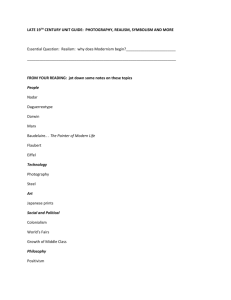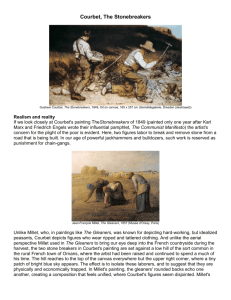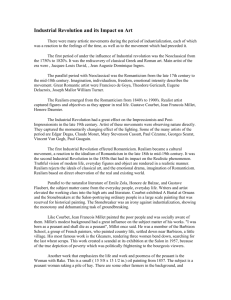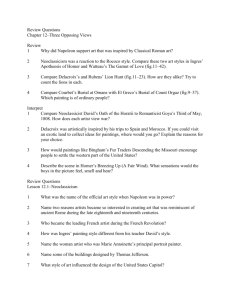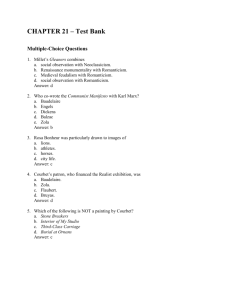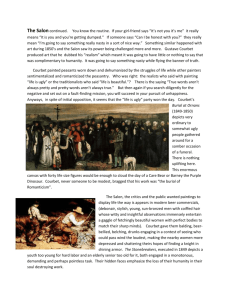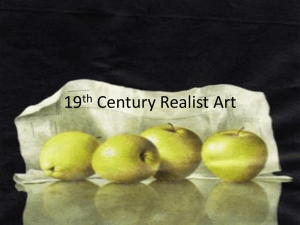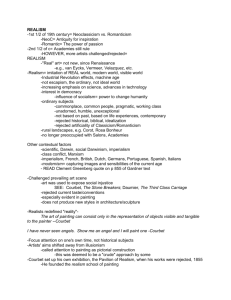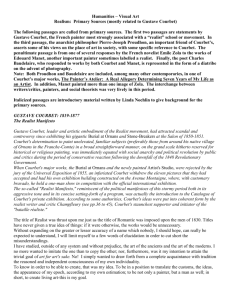Realism Notes
advertisement
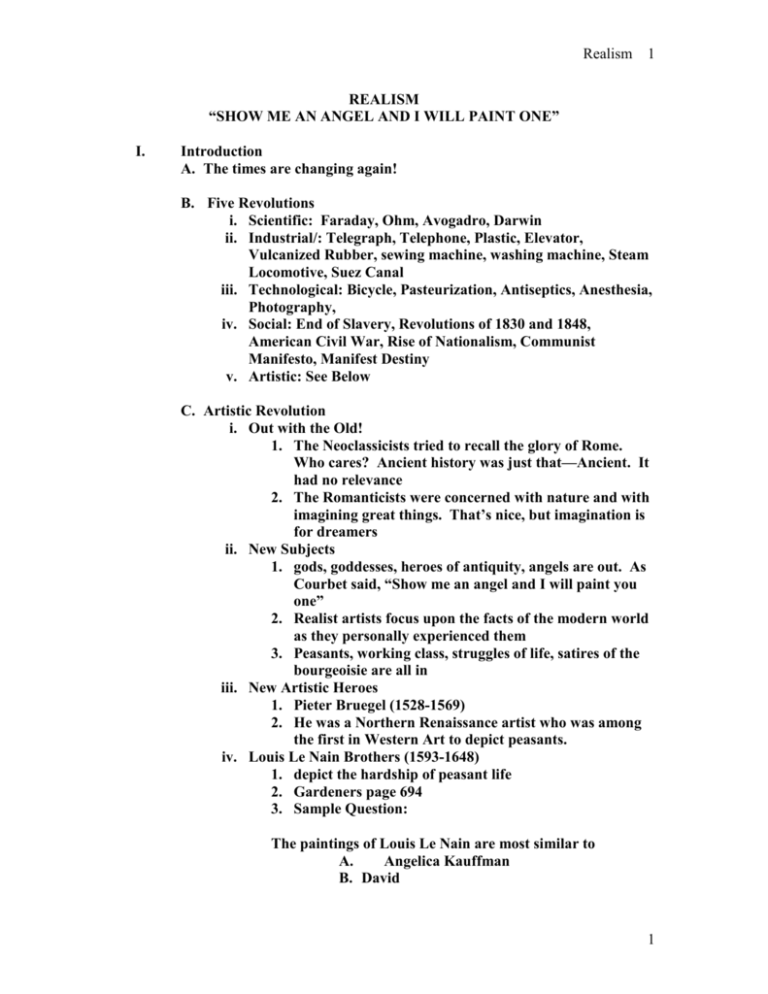
Realism 1 REALISM “SHOW ME AN ANGEL AND I WILL PAINT ONE” I. Introduction A. The times are changing again! B. Five Revolutions i. Scientific: Faraday, Ohm, Avogadro, Darwin ii. Industrial/: Telegraph, Telephone, Plastic, Elevator, Vulcanized Rubber, sewing machine, washing machine, Steam Locomotive, Suez Canal iii. Technological: Bicycle, Pasteurization, Antiseptics, Anesthesia, Photography, iv. Social: End of Slavery, Revolutions of 1830 and 1848, American Civil War, Rise of Nationalism, Communist Manifesto, Manifest Destiny v. Artistic: See Below C. Artistic Revolution i. Out with the Old! 1. The Neoclassicists tried to recall the glory of Rome. Who cares? Ancient history was just that—Ancient. It had no relevance 2. The Romanticists were concerned with nature and with imagining great things. That’s nice, but imagination is for dreamers ii. New Subjects 1. gods, goddesses, heroes of antiquity, angels are out. As Courbet said, “Show me an angel and I will paint you one” 2. Realist artists focus upon the facts of the modern world as they personally experienced them 3. Peasants, working class, struggles of life, satires of the bourgeoisie are all in iii. New Artistic Heroes 1. Pieter Bruegel (1528-1569) 2. He was a Northern Renaissance artist who was among the first in Western Art to depict peasants. iv. Louis Le Nain Brothers (1593-1648) 1. depict the hardship of peasant life 2. Gardeners page 694 3. Sample Question: The paintings of Louis Le Nain are most similar to A. Angelica Kauffman B. David 1 Realism 2 C. Delacroix D. Bruegel v. Jean Baptist Chardin (1699-1779) 1. Rococo period 2. dismissed the frivolities of Rococo and instead depicted quiet middle class scenes praising simple goodness 3. Gardeners page 760 II. Gustave Courbet (1819-1877) A. Brief biography i. Son of a well to do farmer, born in Ornans ii. Proud of his Assyrian beard iii. Moved to Paris at 20, struggled for years as an artist iv. His break came after the 1848 Revolution, he was the leader of the Realist school B. Realist Manifesto: “To create a living art” i. Realism was committed to contemporary social issues ii. Focused on people and subjects that the artists could see for themselves iii. “to be able to translate the customs, ideas, and appearances of my time as I see them—in a word, to create a living art—this has been my aim…Show me an angel and I’ll paint one.” C. Key works i. The Stone Breakers (Gardener 856) 1. nothing outwardly offensive 2. the painting depicts a youth assisting an older man in breaking stones 3. the painting shocked and angered critics and the French public alike 4. Why? Courbet broke the rules a. No idealized figures 2 Realism 3 b. Commonplace figures seem trite and even vulgar c. Courbet focuses on the drudgery of the labor 5. Nonetheless a timely piece. In 1848, workers rebelled against the bourgeoisie leaders for better working conditions. VERY TIMELY ii. A Burial at Ornans (Gardner 892) 10’ by 20’ 1. nearly 60 lifesize figures 2. depicts the townspeople of Ornans, gathered for the funeral of Courbet’s grandfather, Oudot. 3. Male and female mourners are separated in Catholic fashion 4. Critics hated the painting: a. Focus on common people b. Too large, should have been reserved for historical events c. Participants were lined up and not in pyramidal composition to give a better understanding of importance iii. The Painter’s Studio: A Real Allegory Summing up Seven Year’s of my Artistic and Moral Life, 1855 1. its big- 11’10” by 19’ 7” 2. was Courbet’s centerpiece of the Pavilion of Reason 3. It is complex, however we know a great deal from Courbet’s writing a. Left: “the people” they are drawn largely from his home environment of Ornans & include hunters, peasant workers, a priest, a young mother, and her baby. b. Right: portraits of friends, members of Courbet’s own artistic and literary group, an art collector and his fashionable wife, and a pair of lovers. Many are recognizable. 3 Realism 4 i. Courbet’s patron- JL Alfred Bruyas ii. Charles Baudelaire- seated on far right reading a book iii. Young boy on floor sketching- Courbet as a boy c. Central: Courbet’s conception of himself as an artist and his place in the history of western art. i. Note the similarities and differences with Las Meninas and Family of Charles IV. Courbet places himself as the centerpiece ii. Courbet is enthroned before his canvas iii. note the life size wooden doll behind the canvas. Conventional artists would spend hours copying the doll. It symbolizes conventional art, which Courbet is rejecting iv. A nude woman inspires the painter/king. She is behind him, and he is NOT painting her portrait. He turns his back on her, thus rejecting the academic tradition in the form of the classical nude. v. A small boy stands at Courbet’s knee and stares at his work. Perhaps personifying the untrained, child-like admiration that Courbet hoped to arouse in the public. vi. Courbet is painting a realistic landscape. 4. Eleven of Courbet’s paintings were accepted by the 1855 Paris World’s Fair but The Studio was rejected by the jury. Courbet then rented an exhibition space nearby, where he hung 40 of his paintings, the first one man show in art history (a forerunner of the Salon des Refusés). However, the public ignored the show, and the critics derided it. Delacroix supported the work Influenced Manet’s work. III. Jean Francois Millet (1814-1878) A. Brief facts 4 Realism 5 i. Son of a farm laborer ii. Member of the BARBIZON SCHOOL. A group of artists who worked in Barbizon, a small village outside of Paris. B. Key Paintings i. The Gleaners —depicts 3 peasant women performing the back breaking task of gleaning the last scraps of wheat. The impoverished women were permitted to pick up the remainders left in the field after the harvest. IV. Rosa Bonheur (1822-1899) A. Brief facts i. Daughter of an artist ii. Specialized in painting animals iii. Most successful female artist of her time. She was named the first woman artist of the Legion of Honor. B. The Horse Fair (MET) Gardner 898 i. She attended the Paris horse fair dressed as a man to avoid attention. ii. She observed the fair twice a week for a year iii. The painting was a huge success in both Europe and America V. Honore Daumier (1808-1879) A. Brief facts i. Bold political satirist. Cartoons and prints appeared in “ La Caricature” ii. Also a skilled artist B. Key works i. Louis Phillipe as Gargantua- a never satisfied king exploits his subjects and grows fat at their expense. He was sentenced t 6 months in jail for inciting contempt and hatred for the French government ii. Rue Transnonain 1834… 5 Realism 6 1. April 5, 1834 workers rioted in Paris to demonstrate against harsh working conditions. 2. on April 14-15 a sniper in Paris killed an officer 3. In retaliation, a number of people in the sniper’s building were killed, including the father and son in Daumier’s lithograph. 4. This is not a caricature… it is a blood stained page in the history of our days, traced by a vigorous hand and inspired by noble indignation… he has created a picture which will never lose its worth or duration, even if it consists of only black lines on a sheet of paper. --Charles Philipon iii. First Class Carriage iv. Third Class Carriage (MET) 1. A glimpse into the cramped and grimy railway carriage of the 1860’s 2. 3rd class passengers were crammed together on hard benches that filled the carriage VI. Edouard Manet (1832-1883) A. Introduction i. Came from a bourgeoise family. Father was a high ranking official in the Ministry of Justice and his mother came from a long line of diplomats ii. He was the prodigal son. Although the family wanted him to study law, he failed the entrance exam iii. He was sent to sea as a cadet. Life at sea did not agree with him and he could not tie typical nautical knots. iv. He announces plans to be an artist, despite the families objections v. Not since Giotto in the 14th century had an artist so truly deserved the epithet revolutionary. B. Luncheon on the Grass (7’ by 8’ 10”) i. What are we looking at? Figures and composition 6 Realism 7 1. figures a. the foreground figures are all portraits of contemporary people. The seated nude is Victorine Meurend, Manet’s favorite model at the time. The gentlemen are his brother Eugene (cane) and the sculptor Ferdiand Leehof. Victorine looks directly at the viewer without shame. A second woman is bathing in the background. 2. Composition a. The composition is based upon painting by Giorgione. ii. The Salon 1. held every 2 years in Paris 2. Out of 5000 works submitted in 1863, 2800 were rejected by the jury. 3. This was an artists only contact with critics 4. One young painter learning that his painting was rejected, committed suicide. 5. Luncheon on the Grass was REJECTED. BUT WAIT, THE STORY DOES NOT END HERE, THERE IS MORE iii. The Salon des Refuses – 1863 1. Napoleon III, responding to criticisms, decided to allow those rejected to show at a different exhibition 2. The Salon des Refuses, as the counter salon came to be called marks a watershed date in history of modern painting: henceforth the body artistic split into the “academics” and the independents. 3. In 1863 the Ecole’s (school) undisputed authority ended and the AVANT-GARDE was born. AVANT-GARDE refers to art that was innovative and experimental iv. Reactions to Luncheon on the Grass 7 Realism 8 1. Indecent! Shocking! Shows ordinary men and promiscuous women in a Paris park. 2. The way it was painted was new: Loosely painted background with sharp foreground figures. Strong contrasts created with only a few gradations of value which flattens the forms and makes them pop out of the painting. 3. Manet said the principle actor in the painting is light. C. More Scandal i. Olympia, 1863 1. What is painted a. Young, white prostitute. b. Completely nude except for mules, neck ribbon, bracelet and orchid in her hair: Makes her seem even MORE naked. c. Looks viewer indifferently in the eye. Hand over crotch: Closed for business? d. A black maid offers her a gift from a client to which she seems completely indifferent. e. Black and white together was even more depraved: reference to racial divisions 2. How it is painted a. A critic: a courtesan with dirty hands and wrinkled feet …her body has the livid tint of a cadaver…her outline is drawn in charcoal and her greenish, bloodshot eyes appear to be provoking the public, protected all the while by a hideous Negress. b. Negative response was not just to the subject but how it was painted as well. Manet’s brush strokes are rougher and the shifts in tonality are more abrupt than traditional academic painting. c. See Bouguereau, Nymphs and Satyr, for comparison. 8 Realism VII. 9 Germany and the U.S. A. WILLIAM LEIBL, Three Women in a Village Church, 1878-1882. Oil on canvas, 2’ 5” x 2’ 1”. Kunsthalle, Hamburg. i. Expression of compassionate view of subjects. A character study without sentimentality. ii. Three generations of women with virtues of simplicity, honesty, and patience. iii. Captures details like rough hands. B. WINSLOW HOMER, Veteran in a New Field, 1865. Oil on canvas, 2’ 1/8” x 3’ 2 1/8”. Metropolitan Museum of Art, New York (bequest of Miss Adelaide Milton de Groot, 1967). i. About the transition from a nation at civil war to a nation at peace (link to Washington/Cincinnatus). ii. U.S. smooth transition from war to peace a testament to greatness of nation. C. THOMAS EAKINS, The Gross Clinic, 1875. Oil on canvas, 8’ x 6’ 6”. Philadelphia Museum of Art, Philadelphia. i. Showed realities of human experience with need for accurate depiction of truth. Knowledge is a prerequisite for art. Corresponds to late 19th century faith in empiricism: knowledge through the senses and experience. 1. Used photography and other technology (see Muybridge, later) to study anatomy and motion. ii. Public’s increasing faith in progress with science and medicine. iii. Mother covering her face in iv. Compare to Rembrandt’s Anatomy Lesson of Dr. Tulp 1. Technology: Anesthesia (live subject not a cadaver) 2. Everyone is “in” the scene. All involved in the action. D. JOHN SINGER SARGENT, The Daughters of Edward Darley Boit, 1882. Oil on canvas, 7’ 3 3/8” x 7’ 3 5/8”. Museum of Fine Arts, Boston (gift of Mary Louisa Boit, Florence D. Boit, Jane Hubbard Boit, and Julia Overing Boit, in memory of their father, Edward Darley Boit). 9 Realism 10 i. American ex-patriot contemporary of Eakins settled in London ii. Looser brush work than Eakins. iii. Studied paint application of Velazquez (thin layers). iv. He knew subjects of painting and they are at ease posing for him. Gets individual personalities and sense of the different ages of the girls. v. Realist belief: record modern people in modern times. E. HENRY OSSAWA TANNER, The Thankful Poor, 1894. Oil on canvas, 2’ 11 1/2” x 3’ 8 1/4”. Collection of William H. and Camille Cosby. i. Studied with Eakins and then moved to Paris where he painted scenes of life of ordinary people he was raised with in Pennsylvania. ii. Quiet dignity like Millet. Lighting expresses reverent spirit. F. EDMONIA LEWIS, Forever Free, 1867. Marble, 3’ 5 1/4” high. James A. Porter Gallery of Afro-American Art, Howard University, Washington, D.C. i. Neoclassical in style but depicted contemporary scenes. ii. Women had more access to art training in 19th C. VIII. Pre-Raphaelite Brotherhood England. Realism did not appeal to PRB. Wanted to represent fictional, historical, and fanciful subjects with convincing illusion. Organized in 1848 around desire to create art free from the artificial manner propagated by academies formed by successors of Raphael. Distaste for ugliness of contemporary industrialized world. Wanted to express idealism and spirituality of Middle Ages and Early Renaissance. A. JOHN EVERETT MILLAIS, Ophelia, 1852. Oil on canvas, 2’ 6” x 3’ 8”. Tate Gallery, London 10 Realism 11 i. “The poet of meticulous detail.” Unswerving attention to visual fact. B. DANTE GABRIEL ROSSETTI, Beata Beatrix, ca. 1863. Oil on canvas, 2’ 10” x 2’ 2”. Tate Gallery, London. i. Produced portraits of women with ethereal beauty and sensual allure. ii. Portrait of his wife who had recently died of an overdose of opium – note red dove (symbol of love and death) depositing a poppy (symbol of sleep and death) in her hands. IX. Architecture Nations used past as evidence of their greatness. Chateaubriand, Genius of Christianity, (see fig. 30 – 6, Burial of Atala): Defended religion because of its beauty and mystery not truth. o Gothic cathedrals were like Gallic sacred groves and are manifestations of France’s holy history. o New respect for Gothic style. A. CHARLES BARRY and A. W. N. PUGIN, Houses of Parliament, London, England, designed 1835. a. England also celebrated its medieval heritage with Neo-Gothic movement. b. Pugin believed in the moral purity and spiritual authenticity of religious architecture of Middle Ages. c. He also thought that inferior machine-made works (products of the Industrial Revolution) were replacing hand-made items that had honesty and quality. d. He described design for Parliament as “All Grecian…Tudor [late English Gothic] details on a classical body.” B. JOHN NASH, Royal Pavilion, Brighton, England, 1815–1818. a. “Indian Gothic”: fantasy exterior mixing Islamic domes, minarets, and screens. b. Cast-iron skeleton: Early but hidden use of iron in noncommercial building. 11 Realism 12 c. Prototype of playful architectural exaggerations still found in resorts. C. CHARLES GARNIER, the Opera, Paris, France, 1861-1874 a. Neo-Baroque front and wings like a Baroque central-domed church. b. Baroque layout and ornaments characteristic of Beaux-Arts style that flourished in 19 – 20 C. France i. Based on ideas taught at Ecole des Beaux-Arts 1. Classic principles: a. symmetric design b. interior space extending radially from central axis c. extensive exterior ornamentation. D. HENRI LABROUSTE, reading room of the Bibliotheque SainteGenevieve, Paris, France, 1843-1850. a. Cast –Iron Construction: Tensile strength of iron permitted creation of huge interior spaces: railroad stations, exposition halls. b. Labrouste highlighted new material giving new forms yet was reluctant to give up traditional forms. Tradition of putting classical drapery of steel and concrete forms lasted for years. E. JOSEPH PAXTON, Crystal Palace, London, England, 1850-1851; enlarged and relocated at Sydenham, England, 1852-1854. Detail of a color lithograph by ACHILLE-LOUIS MARTINET, ca. 1862. Private collection. a. Undraped construction popular with greenhouses. Used this method to create gigantic exposition hall for “works of industry.” b. Design still based on basilica, central flat roof “nave” and barrel-vaulted “transept.” X. Photography Invented in 1839 by Daguerre and Talbot 12 Realism 13 Sped tendency of art patronage to masses and away from elite few. A. LOUIS-JACQUES-MANDÉ DAGUERRE, Still Life in Studio, 1837. 6 1/4” x 8 1/4”. Daguerreotype. Collection Société Française de Photographie, Paris. a. French government released technology for free to everyone. b. Still Life in Studio modeled on Dutch vanitas still-lifes B. JOSIAH JOHNSON HAWES and ALBERT SANDS SOUTHWORTH, Early Operation under Ether, Massachusetts General Hospital, ca. 1847. Daguerreotype. Massachusetts General Hospital Archives and Special Collections, Boston. a. Predates Gross Clinic by 30 years. b. Taken from position of a medical student. c. High vantage point flattens space and intrigued Impressionists (later). C. HONORÉ DAUMIER, Nadar Raising Photography to the Height of Art, 1862. Lithograph, 10 3/4” x 8 3/4”. Museum of Fine Arts, Boston. a. Nadar used improved technology (wet-plate = calotype) which allowed him greater detail and value (light/dark) contrast. b. Nadar took first aerial photo of Paris from a balloon. D. NADAR, Eugène Delacroix, ca. 1855. Modern print, 8 1/2”x 6 2/3” from original negative in the Bibliothèque Nationale, Paris. E. JULIA MARGARET CAMERON, Ophelia, Study no. 2, 1867. Albumen print, 1' 1" x 10 2/3". George Eastman House, Rochester (gift of Eastman Kodak Company; formerly Gabriel Cromer Collection) a. “Art” photographs intentionally soft focus to portray sitters as fictional characters. Similar intent to Pre-Raphaelites. F. TIMOTHY O’SULLIVAN, A Harvest of Death, Gettysburg, Pennsylvania, July 1863. Negative by Timothy O’Sullivan. Original print by ALEXANDER GARDNER, 6 3/4" x 8 3/4". New York Public Library (Astor, Lenox and Tilden Foundations, Rare Books and Manuscript Division), New York. 13 Realism 14 a. Documentary photos: U.S. Civil War. Unsparing, truthful detail of war. Vividly shows high price of war in a way an engraving or drawing cannot. G. EADWEARD MUYBRIDGE, Horse Galloping, 1878. Collotype print, 9” x 12”. George Eastman House, Rochester, New York. a. Created technology to settle a bet whether a galloping horses hooves all left the ground at a point in the stride. b. Muybridge settled bet but continued to use technology to study motion. Compiled in Animal Locomotion. c. Created a zoopraxiscope to project images sequentially. Forerunner of motion pictures. i. Persistence of vision. X. BRIEF REVIEW- SAMPE ETS QUESTIONS 1. Hudson River School artists were famous for their a. Still lifes b. Landscapes c. Portraits d. Genre scenes 2. Francisco Goya is known for all the following EXCEPT a. Graphic series based on war b. Depictions of nightmarish figures c. Royal portraits d. Pure landscapes 3. Most of Honore Daumier’s graphic works were intended for a. Aristocratic collections b. Religious tracts c. Print dealers 14 Realism 15 d. Popular press 4. The work of Delacroix exemplifies a. Expressionism b. Impressionism c. Romanticism d. Realism 5. In his painting, the French 18th century artist Chardin frequently represented a. Ideal landscapes b. Middle-class domestic life c. Historical and literary themes d. The life of the aristocracy and monarchy 6. the concept of a divinely sanctioned Manifest Destiny was reinforced by the majestic landscapes of a. West and Copely b. Cole and Church c. Sargent and Eakins d. Bonheur and Manet 7. All of the following are associated with 19th century Realism except a. Courbet b. Friedrich c. Millet d. Daumier 8. Rosa Bonheur is most celebrated for painting which of the following? a. Historical scenes 15 Realism 16 b. Animals c. Neoclassical subjects d. Still lifes 9. The statement “I cannot paint an angel because I have never seen one” was made by which of the following artists? a. David b. Ingres c. Delacroix d. Courbet 10. French romantic sculptor who specialized in portraying animals a. Rude b. Canova c. Houdon d. Barye 16
